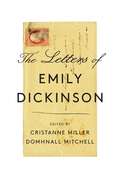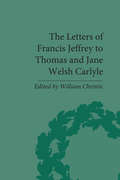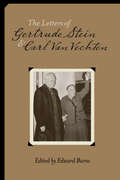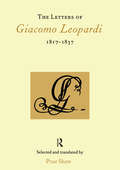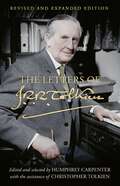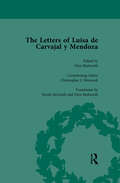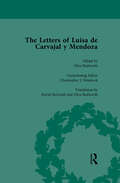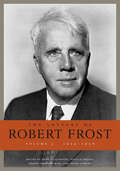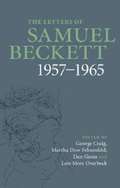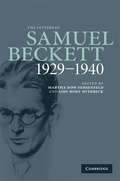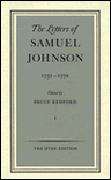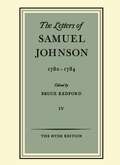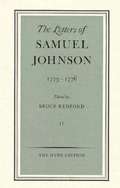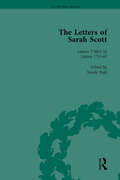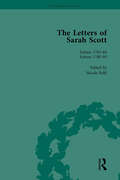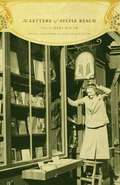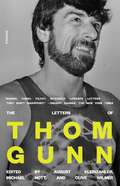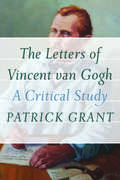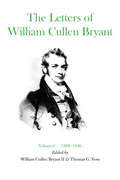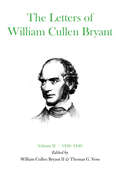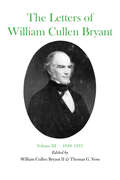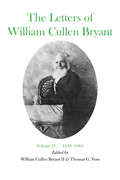- Table View
- List View
The Letters of Emily Dickinson
by Emily DickinsonThe definitive edition of Emily Dickinson’s correspondence, expanded and revised for the first time in over sixty years.Emily Dickinson was a letter writer before she was a poet. And it was through letters that she shared prose reflections—alternately humorous, provocative, affectionate, and philosophical—with her extensive community. While her letters often contain poems, and some letters consist entirely of a single poem, they also constitute a rich genre all their own. Through her correspondence, Dickinson appears in her many facets as a reader, writer, and thinker; social commentator and comedian; friend, neighbor, sister, and daughter.The Letters of Emily Dickinson is the first collected edition of the poet’s correspondence since 1958. It presents all 1,304 of her extant letters, along with the small number available from her correspondents. Almost 300 are previously uncollected, including letters published after 1958, letters more recently discovered in manuscript, and more than 200 “letter-poems” that Dickinson sent to correspondents without accompanying prose. This edition also redates much of her correspondence, relying on records of Amherst weather patterns, historical events, and details about flora and fauna to locate the letters more precisely in time. Finally, updated annotations place Dickinson’s writing more firmly in relation to national and international events, as well as the rhythms of daily life in her hometown. What emerges is not the reclusive Dickinson of legend but a poet firmly embedded in the political and literary currents of her time.Dickinson’s letters shed light on the soaring and capacious mind of a great American poet and her vast world of relationships. This edition presents her correspondence anew, in all its complexity and brilliance.
The Letters of Evelyn Waugh
by Evelyn Waugh Mark AmoryThe correspondence of English author Evelyn Waugh, who lived from 1903 to 1966.
The Letters of Francis Jeffrey to Thomas and Jane Welsh Carlyle (The Pickering Masters)
by William ChristieContains letters from Francis Jeffrey (1773-1850) to Thomas Carlyle (1795-1881) and Jane Welsh Carlyle (1801-1866). The letters in this title present a personal and intellectual narrative of nineteenth-century Britain.
The Letters of Gertrude Stein and Carl Van Vechten, 1913-1946
by Gertrude Stein Carl Van VechtenThis monumental collection of correspondence between Gertrude Stein and critic, novelist, and photographer Carl Van Vechten provides crucial insight into Stein's life, art, and artistic milieu as well as Van Vechten's support of major cultural projects, such as the Harlem Renaissance. From their first meeting in 1913, Stein and Van Vechten formed a unique and powerful relationship, and Van Vechten worked vigorously to publish and promote Stein's work. Existing biographies of Stein—including her own autobiographical writings—omit a great deal about her experiences and thought. They lack the ordinary detail of what Stein called "daily everyday living": the immediate concerns, objects, people, and places that were the grist for her writing. These letters not only vividly represent those details but also showcase Stein and Van Vechten's private selves as writers. Edward Burns's extensive annotations include detailed cross-referencing of source materials.
The Letters of Giacomo Leopardi 1817-1837
by Prue Shaw"Giacomo Leopardi, Italy's great poet of the Romantic age, is the author of some of the most beautiful and best-loved poems in the Italian language and some of the most remarkable letters in European literature. The interest of the letters in both biographical and literary: they document the background - the difficult personal circumstances, the intense and troubled family relationships, the contacts and friendships with other writers - against which a haunting and compelling poetic voice came to maturity. The letters, not previously available in English except fragmentarily, are here offered in a new translation undertaken to celebrate the poet's birth in 1798. In the light of growing academic interest in Italy and the re-organization of many university courses in Italian along interdisciplinary lines, this book series brings together different scholarly perspectives on Italy and its culture. Italian Perspectives incorporates books and essay collections and is published under Maney's Northern University Press Imprint. It is notable for the breadth and diversity of themes covered, incorporating all aspects and periods of Italian literature, language, history, culture, politics, art and media, as well as studies which take an interdisciplinary approach and are methodologically innovative. The series welcomes books written in English and in Italian. The Italian Perspectives series is edited by two established scholars in the field of Italian studies, supported by an international Advisory Board."
The Letters of J.R.R. Tolkien: Revised and Expanded Edition
by J.R.R. TolkienThe comprehensive collection of letters spanning the adult life of one of the world’s greatest storytellers, now revised and expanded to include more than 150 previously unseen letters, with revealing new insights into The Hobbit, The Lord of the Rings and The Silmarillion.J.R.R. Tolkien, creator of the languages and history of Middle-earth as recorded in The Hobbit, The Lord of the Rings and The Silmarillion, was one of the most prolific letter-writers of the last century. Over the years he wrote a mass of letters—to his publishers, to members of his family, to friends, and to “fans” of his books—which often reveal the inner workings of his mind, and which record the history of composition of his works and his reaction to subsequent events.A selection from Tolkien’s correspondence, collected and edited by Tolkien’s official biographer, Humphrey Carpenter, and assisted by Christopher Tolkien, was published in 1981. It presented, in Tolkien’s own words, a highly detailed portrait of the man in his many aspects: storyteller, scholar, Catholic, parent, friend, and observer of the world around him.In this revised and expanded edition of The Letters of J.R.R. Tolkien, it has been possible to go back to the editors’ original typescripts and notes, restoring more than 150 letters that were excised purely to achieve what was then deemed a “publishable length.” and present the book as originally intended.Enthusiasts for his writings will find much that is new, for the letters not only include fresh information about Middle-earth, such as Tolkien’s own plot summary of the entirety of The Lord of the Rings and a vision for publishing his “Tales of the Three Ages,” but also many insights into the man and his world. In addition, this new selection will entertain anyone who appreciates the art of letter-writing, of which J.R.R. Tolkien was a master.
The Letters of Luisa de Carvajal y Mendoza Vol 1
by Glyn Redworth Christopher J HenstockLuisa de Carvajal y Mendoza (1566–1614) was a noblewoman who left her native Spain for a life of self-imposed exile and Catholic evangelism in Jacobean England. Her letters provide an unparalleled resource. This edition presents 180 letters, newly translated and set in context.
The Letters of Luisa de Carvajal y Mendoza Vol 2
by Glyn Redworth Christopher J HenstockLuisa de Carvajal y Mendoza (1566–1614) was a noblewoman who left her native Spain for a life of self-imposed exile and Catholic evangelism in Jacobean England. Her letters provide an unparalleled resource. This edition presents 180 letters, newly translated and set in context.
The Letters of Robert Frost
by Robert FrostOne of the acknowledged giants of twentieth-century American literature, Robert Frost was a public figure much celebrated in his day. Although his poetry reached a wide audience, the private Frost--pensive, mercurial, and often very funny--remains less appreciated. Following upon the publication of Frost's notebooks and collected prose, "The Letters of Robert Frost" is the first major edition of the poet's written correspondence. The hundreds of previously unpublished letters in these annotated volumes deepen our understanding and appreciation of this most complex and subtle of verbal artists. Volume One traverses the years of Frost's earliest poems to the acclaimed collections "North of Boston "and "Mountain Interval "that cemented his reputation as one of the leading lights of his era. The drama of his personal life--as well as the growth of the audacious mind that produced his poetry--unfolds before us in Frost's day-to-day missives. These rhetorical performances are at once revealing and tantalizingly evasive about relationships with family and close friends, including the poet Edward Thomas. We listen in as Frost defines himself against contemporaries Ezra Pound and William Butler Yeats, and we witness the evolution of his thoughts about prosody, sound, style, and other aspects of poetic craft. In its literary interest and sheer display of personality, Frost's correspondence is on a par with the letters of Emily Dickinson, Robert Lowell, and Samuel Beckett. "The Letters of Robert Frost" holds hours of pleasurable reading for lovers of Frost and modern American poetry.
The Letters of Robert Frost, Volume 3: 1929-1936
by Robert FrostThe third installment of Harvard’s five-volume edition of Robert Frost’s correspondence. The Letters of Robert Frost, Volume 3: 1929–1936 is the latest installment in Harvard’s five-volume edition of the poet’s correspondence. It presents 589 letters, of which 424 are previously uncollected. The critically acclaimed first volume, a Times Literary Supplement Book of the Year, included nearly 300 previously uncollected letters, and the second volume 350 more. During the period covered here, Robert Frost was close to the height of his powers. If Volume 2 covered the making of Frost as America’s poet, in Volume 3 he is definitively made. These were also, however, years of personal tribulation. The once-tight Frost family broke up as marriage, illness, and work scattered the children across the country. In the case of Frost’s son Carol, both distance and proximity put strains on an already fractious relationship. But the tragedy and emotional crux of this volume is the death, in Montana, of Frost’s youngest daughter, Marjorie. Frost’s correspondence from those dark days is a powerful testament to the difficulty of honoring the responsibilities of a poet’s eminence while coping with the intensity of a parent’s grief. Volume 3 also sees Frost responding to the crisis of the Great Depression, the onset of the New Deal, and the emergence of totalitarian regimes in Europe, with wit, canny political intelligence, and no little acerbity. All the while, his star continues to rise: he wins a Pulitzer for Collected Poems in 1931 and will win a second for A Further Range, published in 1936, and he is in constant demand as a public speaker at colleges, writers’ workshops, symposia, and dinners. Frost was not just a poet but a poet-teacher; as such, he was instrumental in defining the public functions of poetry in the twentieth century. In the 1930s, Frost lived a life of paradox, as personal tragedy and the tumults of politics interwove with his unprecedented achievements. Thoroughly annotated and accompanied by a biographical glossary and detailed chronology, these letters illuminate a triumphant and difficult period in the life of a towering literary figure.
The Letters of Samuel Beckett 1957-1965 Volume 3
by Samuel Beckett Martha Dow Fehsenfeld Lois More Overbeck George Craig Dan GunnThis third volume of The Letters of Samuel Beckett focuses on the years when Beckett is striving to find a balance between the demands put upon him by his growing international fame, and his need for the peace and silence from which new writing might emerge. This is the period in which Beckett launches into work for radio, film and, later, into television. It also marks his return to writing fiction, with his first major piece for a decade, Comment c'est (How It Is). Where hitherto he has been reticent about the writing process, now he devotes letter after letter to describing and explaining his work in progress. For the first time Beckett has a woman as his major correspondent: a relationship shown in his intense and abundant letters to Barbara Bray. The volume also provides critical introductions, chronologies, explanatory notes and profiles of Beckett's main correspondents.
The Letters of Samuel Beckett, 1929-1940
by Samuel Beckett Martha Dow Fehsenfeld Lois More Overbeck George Craig Daniel Gunn Dan GunnThe letters written by Samuel Beckett between 1929 and 1940 provide a vivid and personal view of Western Europe in the 1930s, and mark the gradual emergence of Beckett's unique voice and sensibility. The Cambridge University Press edition of The Letters of Samuel Beckett offers for the first time a comprehensive range of letters of one of the greatest literary figures of the twentieth century. Selected for their bearing on his work from over 15,000 extant letters, the letters published in this four-volume edition encompass sixty years of Beckett's writing life (1929-1989), and include letters to friends, painters and musicians, as well as to students, publishers, translators, and colleagues in the world of literature and theatre. For anyone interested in twentieth-century literature and theatre this edition is essential reading, offering not only a record of Beckett's achievements but a powerful literary experience in itself.
The Letters of Samuel Johnson
by Bruce RedfordThe Hyde Edition is also the first systematically to record substantive deletions, which can yield intimate knowledge of Johnson's stylistic procedures, mental habits, and chains of association. Furthermore, its ownership credits document the current disposition of the manuscripts, hundreds of which have changed hands during the last four decades. Finally, the annotation of the letters incorporates the many significant discoveries of postwar Johnsonian scholarship, as well as decoding references that had previously resisted explanation.
The Letters of Samuel Johnson 1782-1784 (The Hyde Edition #Vol. IV)
by Samuel JohnsonThis epistolary endgame includes the breakup of the friendship with Hester Thrale, medical dramas of every description, and a poignant reaching out to new friends and new experiences. The letters of 1782-84 exemplify in abundance what Johnson himself praises and provides, 'the interchange of that social officiousness by which we are habitually endeared to one another.
The Letters of Samuel Johnson: Volume II - 1773-1776
by Samuel JohnsonThe Hyde Edition offers scores of texts transcribed for the first time from the original documents a feature of special importance in the case of Johnson's revealing letters to Hester Thrale, many of which have been available only in expurgated form. The Hyde Edition is also the first systematically to record substantive deletions, which can yield intimate knowledge of Johnson's stylistic procedures, mental habits, and chains of association. Furthermore, its ownership credits document the current disposition of the manuscripts, hundreds of which have changed hands during the last four decades. Finally, the annotation of the letters incorporates the many significant discoveries of postwar Johnsonian scholarship, as well as decoding references that had previously resisted explanation. The result is a far richer understanding of Samuel Johnson's life, work, and milieu.
The Letters of Sarah Scott Vol 1 (The\pickering Masters Ser.)
by Nicole PohlSarah Robinson Scott was a writer, translator and social reformer. While Scott’s legacy presents her as a committed Anglican philanthropist, the letters she wrote reveal her to have been a witty, even savage, commentator on eighteenth-century life.This is the first edition of Scott’s letters to be published and presents all extant copies.
The Letters of Sarah Scott Vol 2 (The\pickering Masters Ser.)
by Nicole PohlSarah Robinson Scott was a writer, translator and social reformer. While Scott’s legacy presents her as a committed Anglican philanthropist, the letters she wrote reveal her to have been a witty, even savage, commentator on eighteenth-century life.This is the first edition of Scott’s letters to be published and presents all extant copies.
The Letters of Sylvia Beach
by Sylvia Beach Keri Walsh No?l Riley FitchFounder of the Left Bank bookstore Shakespeare and Company and the first publisher of James Joyce's Ulysses, Sylvia Beach had a legendary facility for nurturing literary talent. In this first collection of her letters, we witness Beach's day-to-day dealings as bookseller and publisher to expatriate Paris. Friends and clients include Ernest Hemingway, Gertrude Stein, H. D. , Ezra Pound, Janet Flanner, William Carlos Williams, F. Scott Fitzgerald, James Joyce, and Richard Wright. As librarian, publicist, publisher, and translator, Beach carved out a unique space for herself in English and French letters. This collection reveals Beach's charm and resourcefulness, sharing her negotiations with Marianne Moore to place Joyce's work in The Dial; her battle to curb the piracy of Ulyssesin the United States; her struggle to keep Shakespeare and Company afloat during the Depression; and her complicated affair with the French bookstore owner Adrienne Monnier. These letters also recount Beach's childhood in New Jersey; her work in Serbia with the American Red Cross; her internment in a German prison c& and her friendship with a new generation of expatriates in the 1950s and 1960s. Beach was the consummate American in Paris and a tireless champion of the avant-garde. Her warmth and wit made the Rue de l'Od on the heart of modernist Paris.
The Letters of Sylvia Beach
by Sylvia BeachFounder of the Left Bank bookstore Shakespeare and Company and the first publisher of James Joyce's Ulysses, Sylvia Beach had a legendary facility for nurturing literary talent. In this first collection of her letters, we witness Beach's day-to-day dealings as bookseller and publisher to expatriate Paris. Friends and clients include Ernest Hemingway, Gertrude Stein, H. D., Ezra Pound, Janet Flanner, William Carlos Williams, F. Scott Fitzgerald, James Joyce, and Richard Wright. As librarian, publicist, publisher, and translator, Beach carved out a unique space for herself in English and French letters. This collection reveals Beach's charm and resourcefulness, sharing her negotiations with Marianne Moore to place Joyce's work in The Dial; her battle to curb the piracy of Ulysses in the United States; her struggle to keep Shakespeare and Company afloat during the Depression; and her complicated affair with the French bookstore owner Adrienne Monnier. These letters also recount Beach's childhood in New Jersey; her work in Serbia with the American Red Cross; her internment in a German prison camp; and her friendship with a new generation of expatriates in the 1950s and 1960s. Beach was the consummate American in Paris and a tireless champion of the avant-garde. Her warmth and wit made the Rue de l'Odéon the heart of modernist Paris.
The Letters of Thom Gunn
by Thom GunnThe Letters of Thom Gunn presents the first complete portrait of the private life, reflections, and relationships of a maverick figure in the history of British and American poetry. “I write about love, I write about friendship,” remarked Thom Gunn. “I find that they are absolutely intertwined.” These core values permeate his correspondence with friends, family, lovers, and fellow poets, and they shed new light on “one of the most singular and compelling poets in English during the past half-century” (Hugh Haughton, The Times Literary Supplement). The Letters of Thom Gunn, edited by August Kleinzahler, Michael Nott, and Clive Wilmer, reveals the evolution of Gunn’s work and illuminates the fascinating life that informed his poems: his struggle to come to terms with his mother’s suicide; settling in San Francisco and his complex relationship with England; his changing relationship with his life partner, Mike Kitay; the LSD trips that led to his celebrated collection Moly (1971); and the deaths of friends from AIDS that inspired the powerful, unsparing elegies of The Man with Night Sweats (1992).
The Letters of Vincent van Gogh: A Critical Study
by Patrick GrantWhen he died at the age of thirty-seven, Vincent van Gogh left a legacy of over two thousand artworks, for which he is now justly famous. But van Gogh was also a prodigious writer of letters—more than eight hundred of them, addressed to his parents, to friends such as Paul Gauguin, and, above all, to his brother Theo. His letters have long been admired for their exceptional literary quality, and art historians have sometimes drawn on the letters in their analysis of the paintings. And yet, to date, no one has undertaken a critical assessment of this remarkable body of writing—not as a footnote to the paintings but as a highly sophisticated literary achievement in its own right. Patrick Grant’s long-awaited study provides such an assessment and, as such, redresses a significant omission in the field of van Gogh studies. As Grant demonstrates, quite apart from furnishing a highly revealing self-portrait of their author, the letters are compelling for their imaginative and expressive power, as well as for the perceptive commentary they offer on universal human themes. Through a subtle exploration of van Gogh’s contrastive style of thinking and his fascination with the notion of imperfection, Grant illuminates gradual shifts in van Gogh’s ideas on religion, ethics, and the meaning of art. He also analyzes the metaphorical significance of a number of key images in the letters, which prove to yield unexpected psychological and conceptual connections, and probes the relationships that surface when the letters are viewed as a cohesive literary product. The result is a wealth of new insights into van Gogh’s inner landscape.
The Letters of William Cullen Bryant: Volume I, 1809–1836
by William Cullen BryantThis is the only collection ever made of Bryant's letters, two-thirds of which have never before been printed. Their publication was foreseen by the late Allan Nevin as "one of the most important and stimulating enterprises contributory to the enrichment of the nation's cultural and political life that is now within range of individual and group effort.William Cullen Bryant (1794–1878) was America's earliest national poet. His immediate followers—Longfellow, Poe, and Whitman—unquestionably began their distinguished careers in imitation of his verses. But Bryant was even more influential in his long career as a political journalist, and in his encouragement of American art, from his lectures at the National Academy of Design in 1828 to his evocation of the Metropolitan Museum of Art in 1870. Between the appearance of his first major poem, "Thanatopsis," in 1817, and his death sixty-one years later at the age of eight-three, Bryant knew and corresponded with an extraordinary number of eminent men and women. More than 2,100 of his know letters have already been recovered for the present edition.When William Cullen Bryant signed the first of 314 letters in the present volume, in 1809, he was a frail and shy farm boy of fourteen who had nonetheless already won some fame as the satirist of Thomas Jefferson. When he wrote the last, in 1836, he had become the chief poet of his country, the editor of its principal liberal newspaper, and the friend and collaborator of its leading artists and writers. His collected poems, previously published at New York, Boston, and London, were going into their third edition. His incisive editorials in the New York Evening Post were affecting the decisions of Andrew Jackson's administration. His poetic themes were beginning to find expression in the landscape paintings of Robert Weir, Asher Durand, and Thomas Cole.The early letters gathered here in chronological order give a unique picture of Cullen Bryant's youth and young manhood: his discipline in the classics preparatory to an all-too-brief college tenure; his legal study and subsequent law practice; the experiments with romantic versification which culminated in his poetic masterpieces, and those with the opposite sex which led to his courtship and marriage; his eager interest in the politics of the Madison and Monroe Presidencies, and his subsequent activities as a local politician and polemicist in western Massachusetts; his apprenticeship as magazine editor and literary critic in New York City, from which his later eminence as journalist was the natural evolution; the lectures on poetry and mythology which foreshadowed a long career as occasional orator; the collaboration in writing The Talisman, The American Landscape, and Tales of Glauber-Spa, and in forming the National Academy of Design, and the Sketch Club, which brought him intimacy with writers, artists, and publishers; his first trip to the Aemrican West, and his first long visit to Europe, during which he began the practice of writing letters to his newspaper which, throughout nearly half a century, proved him a perceptive interpreter of the distant scene to his contemporaries.Here, in essence, is the first volume of the autobiography of one whom Abraham Lincoln remarked after his first visit to New York City in 1860, "It was worth the journey to the East merely to see such a man." And John Bigelow, who of Bryant's many eulogists knew him best, said in 1878 of his longtime friend and business partner, "There was no eminent American upon whom the judgment of his countrymen would be more immediate and unanimous. The broad simple outline of his character and career had become universally familiar, like a mountain or a sea."
The Letters of William Cullen Bryant: Volume II, 1836–1849
by William Cullen BryantThe second volume of William Cullen Bryant's letters opens in 1836 as he has just returned to New York from an extended visit to Europe to resume charge of the New York Evening Post, brought near to failure during his absence by his partner William Leggett's mismanagement. At the period's close, Bryant has found in John Bigelow an able editorial associate and astute partner, with whose help he has brought the paper close to its greatest financial prosperity and to national political and cultural influence.Bryant's letters lf the years between show the versatility of his concern with the crucial political, social, artistic, and literary movements of his time, and the varied friendships he enjoyed despite his preoccupation with a controversial daily paper, and with the sustenance of a poetic reputation yet unequaled among Americans. As president of the New York Homeopathic Society, in letters and editorials urging widespread public parks, and in his presidency of the New York Society for the Abolition of the Punishment of Death, he gave attention to public health, recreation, and order. He urged the rights of labor, foreign and religious minorities, and free African Americans; his most powerful political effort of the period was in opposition to the spread of slavery through the conquest of Mexico. An early commitment to free trade in material goods was maintained in letters and editorials, and to that in ideas by his presidency of the American Copyright Club and his support of the efforts of Charles Dickens and Harriet Martineau to secure from the United States Congress and international copyright agreement.Bryant's first visit to Great Britain came at the height of his poetic and journalistic fame in 1845, bringing him into cordial intimacy with members of Parliament, scientists, journalists, artists, and writers. In detailed letters to his wife, published here for the first time, he describes the pleasures he took in breakfasting with the literary patron Samuel Rogers and the American minister Edward Everett, boating on the Thames with artists and with diarist Henry Crabb Robinson, spending an evening in the home of Leigh Hunt, and calling on the Wordsworths at Rydal Mount as well as in the distinctions paid him at a rally of the Anti-Corn-Law League in Covent Garden Theatre, and at the annual meeting in Cambridge of the British Association for the Advancement of Science.Equally fresh are most of the letters to prominent Americans, many of them his close friends, such as the two Danas, Bancroft, Cole, Cooper, Dewey, Dix, Downing, Durand, Forrest, Greenough, Irving, Longfellow, Simms, Tilden, Van Buren, and Weir. His letters to the Evening Post recounting his observations and experiences during travels abroad and in the South, West, and Northeast of the United States, which were copied widely in other newspapers and praised highly by many of their subscribers, are here made available to the present-day reader.
The Letters of William Cullen Bryant: Volume III, 1849–1857
by William Cullen BryantDuring the years covered in this volume, Bryant traveled more often and widely than at any comparable period during his life. The visits to Great Britain and Europe, a tour of the Near East and the Holy Land, and excursions in Cuba, Spain, and North Africa, as well as two trips to Illinois, he described in frequent letters to the Evening Post. Reprinted widely, and later published in two volumes, these met much critical acclaim, one notice praising the "quiet charm of these letters, written mostly from out-of-the-way places, giving charming pictures of nature and people, with the most delicate choice of words, and yet in the perfect simplicity of the true epistolary style."His absence during nearly one-fifth of this nine-year period reflected the growing prosperity of Bryant's newspaper, and his confidence in his editorial partner John Bigelow and correspondents such as William S. Thayer, as well as in the financial acumen of his business partner Isaac Henderson. These were crucial years in domestic politics, however, and Bryant's guidance of Evening Post policies was evident in editorials treating major issues such as the Compromise of 1850, the Fugitive Slave Law, the Kansas-Nebraska Bill, the rise of the Republican Party, and the Dred Scott Decision, as well as in his correspondence with such statesmen as Salmon P. Chase, Hamilton Fish, William L. Marcy, Edwin D. Morgan, and Charles Sumner. His travel letters and journalistic writings reflected as well his acute interest in a Europe in turmoil. In France and Germany he saw the struggles between revolution and repression; in Spain he talked with journalists, parliamentary leaders, and the future president of the first Spanish republic; in New York he greeted Louis Kossuth and Giuseppe Garibaldi.Bryant's close association with the arts continued. He sat for portraits to a dozen painters, among them Henry P. Gray, Daniel Huntington, Asher Durand, Charles L. Elliott, and Samuel Laurence. The landscapists continued to be inspired by his poetic themes. Sculptor Horatio Greenough asked of Bryant a critical reading of his pioneering essays on functionalism. His old friend, the tragedian Edwin Forrest, sought his mediation in what would become the most sensational divorce case of the century, with Bryant and his family as witnesses. His long advocacy of a great central park in New York was consummated by the legislature. And in 1852, his eulogy on the life of James Fenimore Cooper became the first of several such orations which would establish him as the memorialist of his literary contemporaries in New York.
The Letters of William Cullen Bryant: Volume IV, 1858–1864
by William Cullen BryantThe years just before and during the Civil War marked the high point of Bryant's influence on public affairs, which had grown steadily since the Evening Post had upheld the democratic Jacksonian revolution of the 1830s. A founder of the Free Soil Party in 1848 and the Republican Party in 1856, Bryant was lauded in 1857 by Virginia anti-slavery leader John Curtis Underwood, who wrote to Eli Thayer, "What a glory it would be to our country if it could elect this man to the Presidency-the country not he would be honored & elevated by such an event."In 1860 Bryant helped secure the Presidential nomination for Abraham Lincoln, and was instrumental in the choice of two key members of his cabinet, Salmon Chase as Secretary of the Treasury, and Gideon Welles as Secretary of the Navy. During disheartening delays and defeats in the early war years, direct communications from Union field commanders empowered his editorial admonitions to such a degree that the conductor of a national magazine concluded that the Evening Post's "clear and able political leaders have been of more service to the government of this war than some of its armies."Bryant's correspondence with statesmen further reflects the immediacy of his concern with military and political decisions. There are thirty-five known letters to Lincoln, and thirty-two to Chase, Welles, war secretary Stanton, and Senators Fessenden, Morgan, and Sumner.This seven-year passage in Bryant's life, beginning with his wife's critical illness at Naples in 1858, concludes with a unique testimonial for his seventieth birthday in November 1864. The country's leading artists and writers entertained him at a "Festival" in New York's Century Club, giving him a portfolio of pictures by forty-six painters as a token of the "sympathy" he had "ever manifested toward the Artists," and the "high rank" he had "ever accorded to art." Poets Emerson, Holmes, Longfellow, Lowell, and Whittier saluted him in prose and verse. Emerson saw him as "a true painter of the face of this country"; Holmes, as the "first sweet singer in the cage of our close-woven life." To Whittier, his personal and public life sounded "his noblest strain." And in the darkest hours of the war, said Lowell, he had "remanned ourselves in his own manhood's store," had become "himself our bravest crown."
